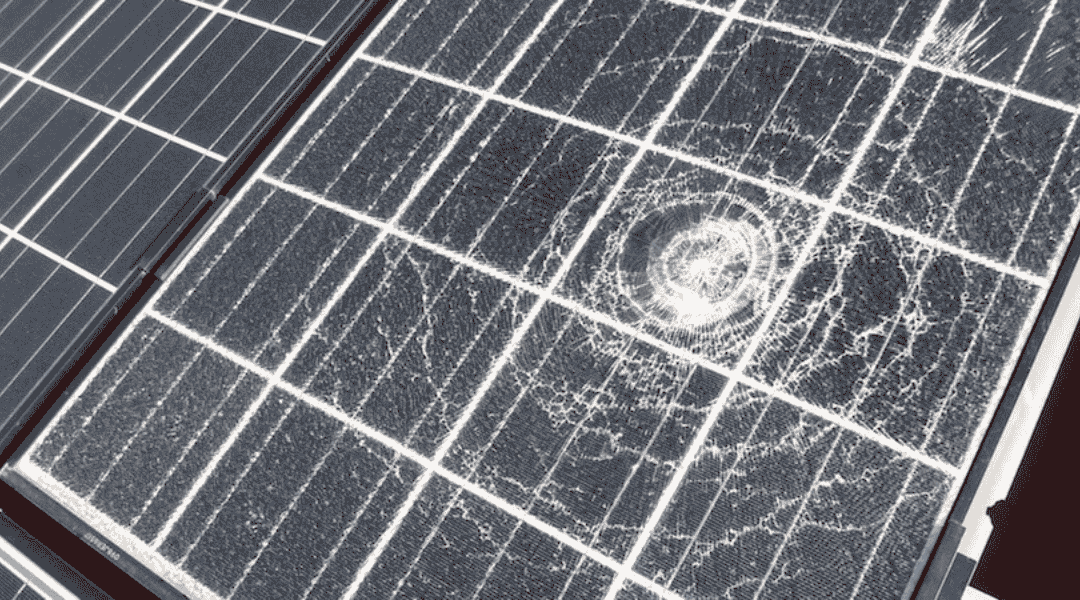Can hail damage solar panels?
In general, hailstones weighing less than 10 g have limited impact on solar panels. However, hailstones weighing over 20 g, or even 30 g (equivalent to the size of an egg), can easily cause damage to the modules.
What are the effects of hail on solar panels?
- Performance decrease
Physical damage caused by hail not only directly affects the appearance of solar panels, but also reduces the power generation efficiency of the PV modules. For example, when cracks appear on the front glass surface of a solar module, the amount of sunlight entering is reduced, leading to lower energy output. Studies have also shown that hail impacts can lead to loss of 2.33% to 4.83% of the power generated by solar modules. - Shortened service life
Hail is usually accompanied by rain, rain or hail melting water through the gap into the panel, exacerbating circuit corrosion and shortening the equipment's lifespan, which in turn affects the overall performance and energy efficiency of the system. - Damage to the power station
Hail impacts may lead to deformation or even collapse of the solar panel bracket and mounting structure, resulting in damage to the solar power station. - Increased operation and maintenance costs
After a hailstorm, the damaged equipment needs to be inspected and repaired. In severe cases of serious damage, equipment replacement is necessary, leading to increased costs for both materials and labor.

What should we do in the face of extreme weather such as hail?
- Use high-quality PV modules
Choose certified PV modules that have passed tests such as UL and CSA. Because obtaining these certifications requires rigorous testing under the maximum static load (wind load, snow load) of 5400Pa, the maximum static load (wind load) of 2400Pa on the back, and the impact of hailstones with a diameter of 25mm at a speed of 23m/s per second.which makes the modules more resistant to the impact of hailstones. - Reinforce support structures
Use high-strength materials such as aluminum alloys or galvanized steel for support structures, and reinforce the bases to ensure the PV modules remain stable during strong winds and hail. A robust structure significantly reduces the risk of collapse due to impact deformation. - Optimize Orientation and Tilt Angle
Research shows that a greater tilt angle results in less damage from hail. In addition, the installation orientation can also reduce the damage caused by hail on PV modules to a certain extent. - Early Warning and Real-Time Monitoring
Many solar power stations are equipped with monitoring systems that track environmental parameters such as light intensity, meteorological data, panel temperature, and power generation. Combined with the early warning information from the meteorological department, adjustments can be made to panel angles or protective measures (like adding a cushioning layer) before hail arrives, minimizing damage.

Conclusion
Overall, solar panels are designed and manufactured with consideration for hail impacts, and they are able to withstand a certain level of impact. Choosing high-quality solar products, along with professional installation and regular maintenance, can effectively reduce the risk of damage from hail.
Recent Posts
Solar Power's Peak Output Isn't Actually in Summer?
How to remove snow from solar farm when cold wave is coming?
An Article to Help You Understand PV-BESS Systems
Agrivoltaics: The Next Era of Agricultural?
What is Gravity Energy Storage?
The Hidden Debt Trap in Solar Plant Financing
20% Power Generation Loss! These Critical Details Are "Stealing" Your Profits!
Several national energy production and operation indicators hit new highs
Contact Us